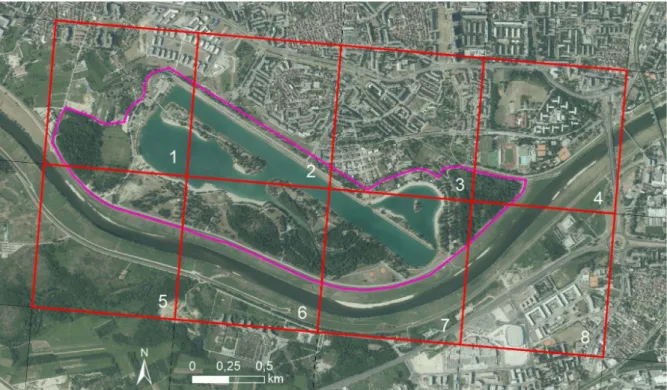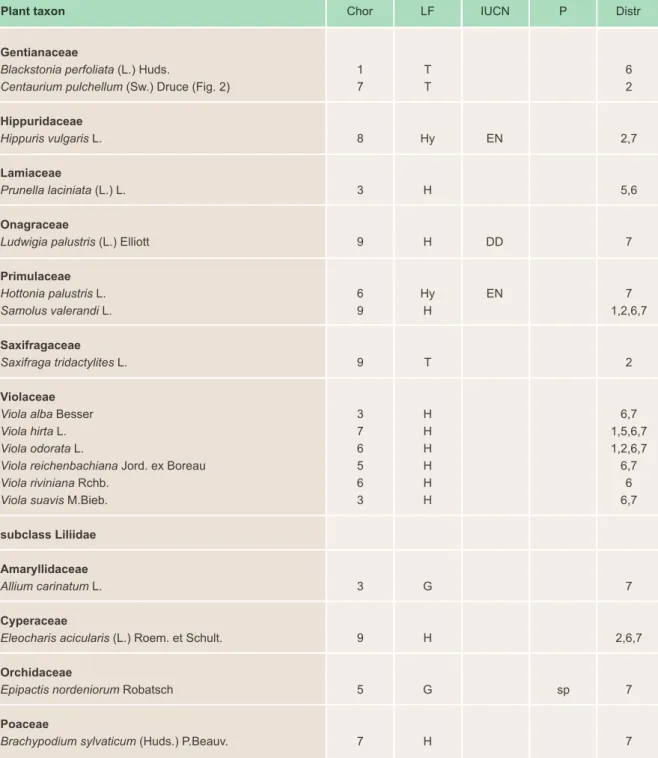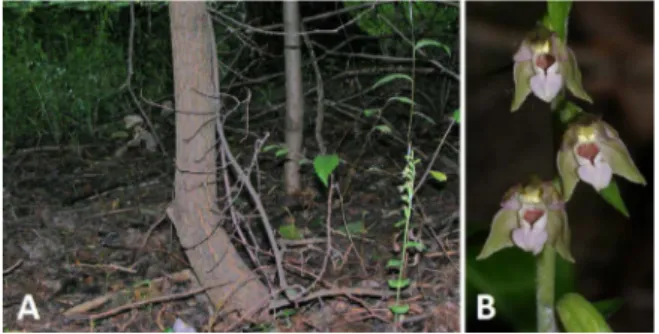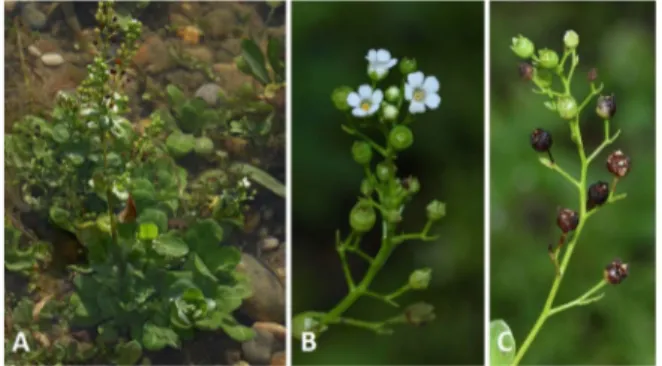Abstract
Twenty new vascular plant species were recorded on
Jarun Recreational and Sports Centre during vegetation
seasons 2011, 2012 and 2015. Those species had not
been noted neither in systematic floristic investigations
in the frames of the project „Countdown towards 2010 in
Tijekom vegetacijskih sezona 2011, 2012 i 2015
na području Rekreacijsko-sportskog centra Jarun
zabilježeno je 20 novih biljnih vrsta koje ovdje nisu
bile zabilježene niti tijekom sustavnih florističkih
istraživanja u okviru projekta “Countdown towards
Jarun Recreational and Sports Centre is situated in the
south-western part of the city of Zagreb (central Croatia).
With an area of 235 ha it includes six islands (Otok
Trešnjevka, Otok Univerzijade, Otok divljine, Otok hrvatske
mladeži, Otok ljubavi and Otok veslača) on two artificial
lakes (Veliko jezero and Malo jezero) which are connected
by regatta course, and surrounding land (Sabolić 2003).
Since it was constructed and landscaped in 1987 it
was only sporadically investigated for its flora. However,
systematic floristic investigations of this complex were
conducted in the frames of the project “Countdown
towards 2010 in Zagreb”, with the results which were
subsequently published by Vuković et al. (2013).
According to those investigations, the flora of Jarun
comprises 323 plant taxa from 70 families in total.
However, we have recorded several new species for
this area and find it interesting to publish our findings.
Material and methods
Numerous field trips to Jarun Recreational and
Sports Centre in the vegetation seasons 2011, 2012 and
Keywords:
new records, Jarun Recreational and Sports Centre, life forms, chorotypes
Čičmir, R., Boršić, I. (2016): Dodatak vaskularnoj flori Jaruna (Zagreb, Hrvatska). Glas. Hrvat.
bot. druš. 4(2): 32-36.
Sažetak
Ključne riječi:
novi nalazi, Rekreacijsko-sportski centar Jarun, životni oblici, florni elementi
Introduction
Zagreb“ nor earlier. New record of rare orchid
Epipactis
nordeniorum
Robatsch and records of two endangered
hydrophytes,
Hippuris vulgaris
L. and
Hottonia palustris
L., are particulary interesting. In total, vascular flora of
Jarun now comprises 343 species and subspecies.
2010 in Zagreb”, a niti ranije. Pri tome se posebno
ističu novi nalaz rijetke orhideje
Epipactis nordeniorum
Robatsch te dvije ugrožene vodene vrste,
Hippuris
vulgaris
L. i
Hottonia palustris
L. Ukupna vaskularna
flora Jaruna sada broji 343 vrste i podvrste.
2015 yielded some interesting floristic observations. For
the identification of plant species standard determination
keys and iconographies were used (e.g. Tutin et al.
1968-1980, Jávorka & Csapody 1991, Tutin et al. 1993,
Domac 1994, Rothmaler 2000). The nomenclature
of taxa was adjusted according to the Flora Croatica
Database (Nikolić 2016). Chorological types and
life-forms were determined in the same way as in Vuković
et al. (2013). Furthermore,
IUCNcategories were
determined according to the Red Book of Vascular Flora
of Croatia (Nikolić & Topić 2005). Species listed in the
Ordinance on Strictly Protected Species (Official Gazette
144/2013) of the Nature Protection Act (Official Gazette
80/2013) were identified as strictly protected plants.
The area of Jarun extends over eight grid cells
of new reference grid 1x1 km (Tab. 1, Fig. 1). It is a
reference grid developed by European Environment
Agency (
EEA) for each
EEAmember country and for
Europe as a whole. Beside the grid resolution of 1 km,
for each country grid resolutions of 10 km and 100 km
are also available (Peifer 2011). Particular species has
been assigned to a grid cell in which it was recorded.
Table 1.
Grid cells of new reference grid 1x1 km of
Jarun Recreational and Sports Centre.
Results and discussion
During our floristic investigations 20 new vascular
plant species were recorded for the area of Jarun
(Tab. 2). Vascular flora of Jarun now comprises 343
species and subspecies in total. With only minor
changes, order of the most abundant plant families
has mostly remained the same as previously
reported. The most dramatic change happened
with the family Violaceae which now contains seven
species in the flora of Jarun, while previously only
one species was recorded (cf. Vuković et al. 2013).
Grid cell name Map label 1kmE4780N2537 1kmE4781N2537 1kmE4782N2537 1kmE4783N2537 1kmE4780N2536 1kmE4781N2536 1kmE4782N2536 1kmE4783N2536 1 2 3 4 5 6 7 8
Figure 1.
Grid cells of new reference grid 1x1 km
(red lines) of Jarun Recreational and Sports Centre
(pink line). For the explanation of numbers of grid
cells see Tab. 1.
Table 2.
Newly recorded vascular plant species for Jarun. Chor – chorological types (1-Mediterranean
(med), 3-South-European (S-europ), 5-Central-European (
C-europ), 6-European (europ), 7-Euro-Asiatic
(euro-asiat), 8-Circum-Holarctic (circ-holarct), 9-Cosmopolites (cosmop)),
LF– life forms (
G-Geophytes,
H
-Hemicryptophytes, Hy-Hydrophytes,
T-Therophytes),
IUCN– threat status (
DD-Data Deficient,
EN-Endangered),
P– legal protection (sp-Strictly protected), Distr – cells in which the species was recorded.
Chor
Plant taxon LF IUCN P Distr
subclass Magnoliidae Asteraceae Centaurea jacea L. Boraginaceae Anchusa officinalis L. 7 6 1,5 5,6,7 H H
In comparison with the data from Vuković at al.
(2013), life-form spectrum for the flora of Jarun
remained almost the same (Fig. 3). Predomination
of hemicryptophytes, followed by therophytes,
geophytes and phanerophytes, with the lowermost
share of hydrophytes and chamaephytes, remains
in accordance with other researched areas in
NWCroatia (e.g. Stančić 1994, Mitić et al. 2007, Hudina
et al. 2012, Alegro et al. 2013).
Figure 2.
Habit of
Centaurium pulchellum
(Sw.) Druce
(
A) and upper part of the plant (
B) (Photo: R. Čičmir).
Lamiaceae
Prunella laciniata (L.) L. Onagraceae
Ludwigia palustris (L.) Elliott Primulaceae Hottonia palustris L. Samolus valerandi L. Saxifragaceae Saxifraga tridactylites L. Violaceae
Viola alba Besser Viola hirta L. Viola odorata L.
Viola reichenbachiana Jord. ex Boreau Viola riviniana Rchb.
Viola suavis M.Bieb. subclass Liliidae Amaryllidaceae Allium carinatum L. Cyperaceae
Eleocharis acicularis (L.) Roem. et Schult. Orchidaceae
Epipactis nordeniorum Robatsch Poaceae
Brachypodium sylvaticum (Huds.) P.Beauv.
3 9 6 9 9 3 7 6 5 6 3 3 9 5 7 5,6 7 7 1,2,6,7 2 6,7 1,5,6,7 1,2,6,7 6,7 6 6,7 7 2,6,7 7 7 H H Hy H T H H H H H H G H G H sp DD EN



